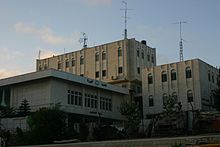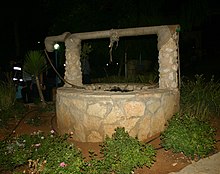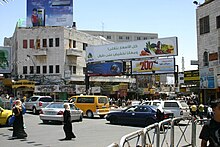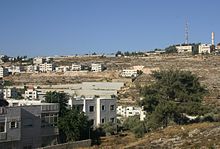al-Bireh
| Al-Bireh | |
|---|---|
| Basic data | |
| Residents : | 46,212 (2014) |
| Height : | middle location: approx. 900 m |
| Area code : | 02 |
| Geographic location : | 31 ° 54 ' N , 35 ° 13' E |
| Website : | City website |
Al-Bireh ( Arabic البيرة, DMG al-Bīra , Palestinian-Arabic il-Bīre , also el-Bira ; Hebrew אָל בִּירֶה) is a city that has grown together with Ramallah in the Palestinian Territories in the West Bank . The city is located 15 kilometers north of Jerusalem at an altitude of 860 m and is the largest city in the Governorate of Ramallah and Al-Bireh with almost 40,000 inhabitants .
In the west the city borders on Ramallah, in the north there is the Jewish settlement of Beit El . The Jewish settlement of Psagot lies on a hill in the east and the Amari refugee camp and the town of Kalandia in the south, where there is now the border crossing to Jerusalem.
Al-Bireh was once on the main road from Jerusalem to Nablus (National Road 60). In the Second Intifada , the north exit at Beit El was closed and road 60 was relocated east of Psagot. The border crossing at Kalandia in the south has been closed to trucks, so that through traffic is gone.
Many government institutions, 5 ministries and also the office of the president, the muqataa , are located on the territory of the municipality. Nevertheless, the city name is almost always not mentioned in favor of Ramallah, although Al-Bireh is the larger city.
The representative offices of Austria and Switzerland are located in the city .
Surname
The name Al-Bireh comes from the Arabic word bi'r /بئر / biʾr / 'Brunnen' and thus corresponds to "Brunn" or "Brünn". A water fountain can also be seen in the city coat of arms.
history
The city developed as a Muslim sister to the once Christian Ramallah until it came together completely. The main shopping streets are the connecting roads between the two cities. Although there are two town halls, there are only one other institution, e.g. B. the vegetable market or the Islamic dish.
On June 6, 1967, the city came under Israeli occupation during the Six Day War . The Military Administration (DCO) for the Ramallah District was housed in the Muqataa .
At the end of the First Intifada , the Psagot settlement received its own driveway from the east, which meant that settlers no longer had to drive through the city.
In the 1990s the city received a new town hall and post office, on the facade of which a verse by Mahmud Darwish is artistically depicted.
After the Palestinian autonomy, the city experienced a tremendous boom. Many wealthy Palestinian emigrants and members of the government came to the city and founded companies, hotels and often built stately villas. The first Palestinian shopping center in the western sense was built in the north. The Ministry of Foreign Affairs, the Ministry of the Interior, the Ministry of Finance and the Ministry of Religion were located in Al-Bireh.
In the late 1990s, the numerous shared taxi stands were replaced by a large parking garage with an integrated bus station next to the vegetable market. The police's use of taxis waiting for guests outside the building eliminated the problem of the chronically congested main road.
At the beginning of the Second Intifada , there were frequent firefights between Israeli soldiers in the Psagot settlement and armed Palestinians, who often holed up at the Islamic cemetery. Later the Muqataa with Yasser Arafat was besieged several times. The economic situation caused many returnees to leave the country again.
In 2005, the community built a new cemetery because the old one near the old town is overcrowded. Since this is at the foot of the hill with the settlement of Psagot, the Israelis banned the use of the area for several years.
On October 26, 2008, an artificial turf soccer field financed by the FIFA Goal Program was inaugurated by FIFA President Sepp Blatter . The foundation stone for the construction of the stadium itself was also laid. The construction of the stands is financed by Germany and France, the outer walls and the scoreboard by the municipality of Al-Bireh. In October 2009, however, the Israeli civil administration surprisingly imposed a construction freeze on the occupied territories due to a lack of building permits - three years after the start of the project and ten months after the construction of the grandstands. The square is also near the Psagot settlement, but political reasons are suspected behind the construction stop. The stadium finally opened in 2011 with the Palestine Cup.
Twin town
-
 Youngstown (Ohio) in the USA .
Youngstown (Ohio) in the USA . -
 Fort Lauderdale (Florida) in the USA .
Fort Lauderdale (Florida) in the USA . -
 Gennevilliers , France
Gennevilliers , France
Web links
- Homepage of Al-Bireh (English / Arabic, in the intro slide show)
Individual evidence
- ↑ http://www.pcbs.gov.ps/Portals/_Rainbow/Documents/ramallah.htm Palestinian Central Statistical Office
- ↑ What does Israel have against a Palestinian stadium? ( Memento from November 22, 2009 in the Internet Archive )




